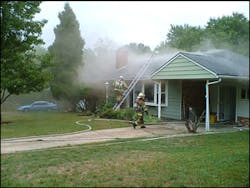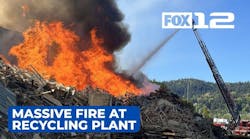A heavy smoke condition and high heat on the first floor of a commercial structure, what does that indicated? A high heat condition on the first floor of a Victorian home with no visible flames, what might be the cause? There is most likely a fire under you in the basement. Basement fires are some of the toughest fires we have to deal with in the fire service today.
What is the risks versus the rewards for a basement fire? The risks are great and the rewards can also be great, but if we have to make a decision, make it with the safety of personnel as the first priority.
Why are there so many risks at a basement fire? The first reason is that we are committing our firefighters and officers to the areas above the fire before we have water on the fire. The operating forces will stage and make attack from an area immediately dangerous to life and health (IDLH) above a working fire and that is a dangerous place to be. Before making the attack, the firefighters operating the handline do not know the conditions in the basement. The basement might be full of stored junk and have a heavy fire load. The basement may have been altered to allow for storage or living space and there might be a door closed at the bottom of the stairs. These conditions make basement fires a dangerous and serious job that must be coordinated and well thought out before the attack can progress.
Commercial Fires
The differences between a commercial basement and a residential basement must also be in the thought process of the incident commander and line officers. In most stores, the basement is a storage or sales area, if exits are provided to code. Either way, this area has limited means of entry and egress and almost no point of ventilation. How can we remove the products of combustion from the basement without allowing the fire spread? These thing need to be addressed before we commit our forces to the basement.
The possibility of structural alteration made without the knowledge of the fire department or building department must not be overlooked. And even if the owner or occupant made changes to the structure with the knowledge of the fire or buildings department, those alterations might not be made to code. This type of situation has been a contributing factor in numerous line of duty deaths, so be aware. In a commercial basement you are working to save stock that is already destroyed and save a building that might already be damaged and ready to fail.
Residential Fires
In a residential structure, the basement is often converted to living space. As a child I remember that our basement was wide open and on rainy days we could ride our bicycles in the basement. My basement now is a study, computer room and workshop. It is divided into different rooms and is a maze to get to my oil burner in the rear of the basement.
In most of today's homes, people are converting that space instead of moving to a new location so basements are becoming a living space. Most newly constructed homes have higher basements with much larger space and that area can be converted to living space after the home is purchased. These new homes might also have a basement apartment to help the homeowner afford the mortgage payment. A converted basement might become a problem because it might not have the access or egress that we expect.
Traditional Tactics are Changing
Basement fires are changing just as the buildings we operate in are changing. We must anticipate the unexpected and prepare for problems before they happen. Our units must be well-trained and well-disciplined and willing to take on the task at hand. They must also be trained enough to realize that if the operation is not going to pan out then we must adapt and change our tactics to overcome the problems.
Basement fires are tough fires and nobody likes them. If someone you know likes basement fires, then stay away from that firefighter as they are dangerous and might get you hurt. Basement fires in commercial buildings are difficult to extinguish and hard to find. Basements in residential buildings have limited access and egress and that makes those fires extremely dangerous. Operate as if your life depended on it, because it does.
Be sure to view Captain Dugan's two webcasts on Firehouse TrainingLIVE: Firefighter Safety with Lightweight Building Construction in 2007 and Ventilation: The Problem And Effect On Today's Buildings.Michael M. Dugan is a 22-year veteran of the FDNY, serving as the Captain of Ladder Company 123, in Crown Heights Brooklyn. As a Lieutenant, Dugan served in Ladder Company 42 in the South Bronx. While assigned as a firefighter in Ladder Company 43, in Spanish Harlem, Firefighter Dugan received the James Gordon Bennett medal in 1992 and the Harry M. Archer Medal in 1993, the FDNY's highest award for bravery. He is also a former volunteer firefighter, with the Halesite Fire Department. He has been involved with the fire service for 32 years.
He was an instructor at the inception of the FDNY's Annual Education Day and has developed programs currently taught to all FDNY members during Annual Education Day. He is the lead instructor for "Engine and Truck Company Hands-on Training (HOT) programs at Firehouse Expo and Firehouse World. He is a contributing editor for Firehouse Magazine. Captain Dugan has been a featured lecturer around the country and at both the Firehouse Expo and the Firehouse World on topics dealing with truck company operations and today's fire service. You can reach Michael by e-mail at: [email protected] or contact him through his website: www.NYFiretraining.com.






